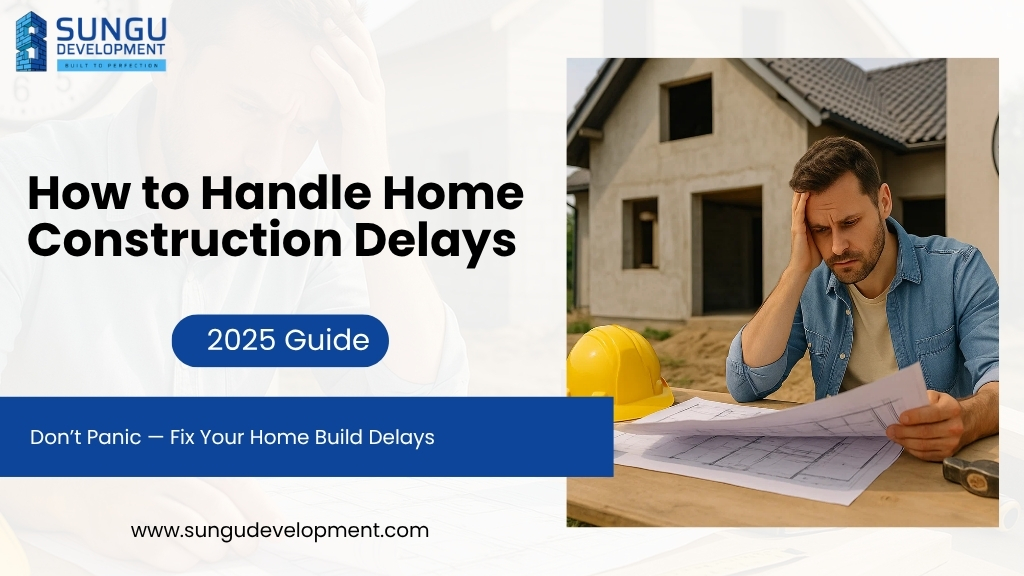
Building a home is a carefully sequenced process that turns a design on paper into a safe, efficient, code-compliant residence. Below is a homeowner-friendly walkthrough of each phase—from planning and permits to final inspection—plus timelines, cost drivers, and quality checkpoints you can use to keep the project on track.
1) Pre-Construction: Planning, Design, and Permits
Goal: Define scope, secure approvals, lock the budget.
Key steps
- Feasibility & Budgeting: Align desired size, style, and features with your budget. Include a 10–15% contingency for surprises.
- Team & Contract: Select a licensed general contractor (or design-build firm), architect, and structural engineer. Use a fixed-price or GMP contract with a clear scope, inclusions/exclusions, allowances, and schedule.
- Design & Drawings: Architectural plans, structural details, energy compliance, and site plan.
- Permits & Approvals: Building permit, zoning clearance, utility approvals, and HOA/ARC (if applicable).
- Surveys & Geotech: Boundary survey and soil report to inform foundation type and drainage.
- Insurance: Builder’s risk and general liability coverage.
Pro tip: Freeze major selections (windows, roofing, HVAC type) before permitting to avoid re-submittals and delays.
2) Site Preparation & Layout
Goal: Prepare a safe, accessible, well-drained site.
- Clear vegetation, demolish old structures if needed, and remove unsuitable soil.
- Install erosion control (silt fence), temporary power/water, and portable sanitation.
- Stake building corners and elevations; establish access for deliveries and concrete trucks.
- Rough grade to direct water away from the future foundation.
3) Foundation Systems
Goal: Build a level, stable, dry base that matches soil conditions.
Common options
- Slab-on-grade: Cost-effective; popular in warm or stable-soil regions.
- Crawl space: Elevates the structure; easier access to utilities.
- Basement: Extra living/storage space; requires waterproofing and drainage.
- Pier/beam or deep foundations: For expansive clays, soft soils, or slopes.
Typical sequence
- Excavation and trenching
- Formwork and reinforcing steel (rebar)
- Footings and stem walls or monolithic slab pour
- Vapor barrier, anchor bolts, and termite treatment (region-dependent)
- Cure concrete, then waterproof and drain (French drain, sump—if required)
Inspection checkpoint: Foundation and footing inspection before backfill.
4) Framing the Structure
Goal: Create the skeleton of the home.
- Floor framing (or slab), then wall framing, then roof framing (trusses or rafters).
- Apply sheathing (OSB/plywood), house wrap, and metal strapping for shear and uplift per code.
- Frame stairs, rough openings for windows and exterior doors.
Inspection checkpoint: Framing inspection (often combined with shear/strapping verification).
5) Roofing, Windows, and Doors (“Dry-In”)
Goal: Weatherproof the shell so interior work can begin.
- Install roof underlayment, shingles/metal/tile, flashing, and ventilation.
- Set windows and exterior doors with proper flashing/tape.
- Temporary heat or dehumidification may be used to protect materials.
6) Rough-In: Mechanical, Electrical, and Plumbing (MEP)
Goal: Run hidden infrastructure inside walls and ceilings.
- Plumbing rough-in: Supply and drain lines; tub/shower pans set early.
- Electrical rough-in: Panel location, circuits, GFCI/AFCI, low-voltage (data, alarm, EV charging conduit).
- HVAC rough-in: Ducts, returns, line sets, bath and kitchen exhausts; verify Manual J/S/D (load, equipment, ducts).
Inspection checkpoint: MEP rough-in inspection—walls remain open.
7) Insulation & Air Sealing
Goal: Achieve code-compliant energy performance and comfort.
- Options: fiberglass batts, blown-in cellulose, spray foam, or mineral wool.
- Seal penetrations (top plates, rim joists, around windows/doors).
- Vapor control strategies vary by climate zone.
Quality tip: Request a blower door test target (e.g., ≤3–5 ACH50 depending on local code) for tighter homes.
8) Drywall & Interior Systems
Goal: Create finished interior surfaces.
- Hang, tape, and finish drywall (multiple coats, sanding).
- Install interior doors, stair railings, and base blocking for cabinets.
- Prime/seal drywall to control moisture and improve paint adhesion.
9) Exterior Finishes
Goal: Protect the structure and elevate curb appeal.
- Siding (fiber cement, vinyl, wood), stucco, or brick/stone veneer.
- Trim, caulking, exterior paint/stain, gutters and downspouts.
- Decks, porches, balconies, and exterior lighting.
10) Interior Finishes & Fixtures
Goal: Complete the look and functionality.
- Cabinetry & countertops (kitchen, baths, laundry).
- Tile & waterproofing in wet areas; shower glass.
- Flooring: hardwood, LVP, tile, carpet.
- Trim & paint: baseboards, casing, crown, accent walls.
- Set fixtures: faucets, toilets, sinks, door hardware, light fixtures, switches, outlets.
- Appliances: kitchen, laundry, ventilation hoods tested.
11) Exterior Works, Landscaping & Final Details
Goal: Safe access, drainage, finished look.
- Driveway/sidewalks, final grading, irrigation and plantings, fencing.
- House numbers, mailbox, and exterior accessories.
- Final clean (interior & exterior).
12) Inspections, Commissioning & Handover
Goal: Verify safety and performance; close out the project.
- Final inspections: building, electrical, plumbing, mechanical, energy.
- Obtain Certificate of Occupancy (CO).
- Commissioning/Startup: HVAC balancing, water heater settings, thermostat programming, smart home devices paired.
- Punch list: Walkthrough to note touch-ups and corrections.
- Handover package: As-builts, manuals, warranties, paint codes, appliance models, and maintenance schedule.
Typical Timeline Snapshot (Indicative Only)
- Pre-construction & permits: 4–12+ weeks
- Sitework & foundation: 2–6 weeks
- Framing to dry-in: 3–8 weeks
- MEP rough-ins & inspections: 3–6 weeks
- Insulation & drywall: 2–4 weeks
- Finishes & fixtures: 4–10 weeks
- Final inspections & handover: 1–3 weeks
Overall: 6–14+ months depending on size, complexity, weather, crew availability, and supply lead times.
Major Cost Drivers (and How to Control Them)
- Size/Complexity: More square footage, complex roofs, or custom details raise costs.
- Site Conditions: Poor soil, slopes, trees, utility distance, or strict stormwater rules.
- Material Choices: Premium windows, stone, or high-end finishes.
- Labor Market: High demand can push bids up.
- Change Orders: Late-stage changes are the biggest budget killer.
Budget tips
- Lock specifications early; use allowances for unknowns with price bands.
- Approve shop drawings promptly to avoid delays.
- Value-engineer hidden areas before visible ones (e.g., framing optimizations vs. finish downgrades).
Quality & Safety Checkpoints You Shouldn’t Skip
- Third-party foundation and framing inspection (beyond building department).
- Moisture management: pan flashing, kick-out flashing, and weep screeds.
- Air sealing: Verify with blower door testing and IR scans if available.
- Water tests for showers and exterior doors before finishes.
- Electrical safety: GFCI/AFCI where required; correct panel labeling.
- Photo documentation of framing and rough-ins before drywall.
Smart & Green Upgrades That Pay Back
- High-performance envelope: better windows, exterior continuous insulation, meticulous air sealing.
- Heat pump HVAC and heat pump water heater for efficiency.
- ERV/HRV for fresh air and humidity control.
- Cool roof or high-reflectance shingles; proper attic ventilation.
- Solar-ready conduit, EV-charger wiring, and smart thermostats.
- Low-flow fixtures and drought-tolerant landscaping.
Simple Homeowner Checklist
Before construction
- Finalize plans, specs, and budget; pick finishes with lead times.
- Confirm permit status and inspection schedule.
- Set communication rhythm (weekly site meetings and reports).
During construction
- Approve submittals quickly; avoid mid-build changes.
- Walk the site at key milestones (post-framing, post-rough-in).
- Track payments against draw schedule and percent complete.
Before move-in
- Perform a detailed punch list walkthrough.
- Collect manuals, warranties, and as-builts.
- Set up a maintenance calendar (filters, caulking, exterior paint checks).
Conclusion
Residential construction is a precise sequence of planning, structure, systems, and finishes—each with its own inspections and quality checks. With a solid budget, a clear scope, and proactive oversight, you can bring your design to life on time and within budget while improving comfort, durability, and efficiency.


